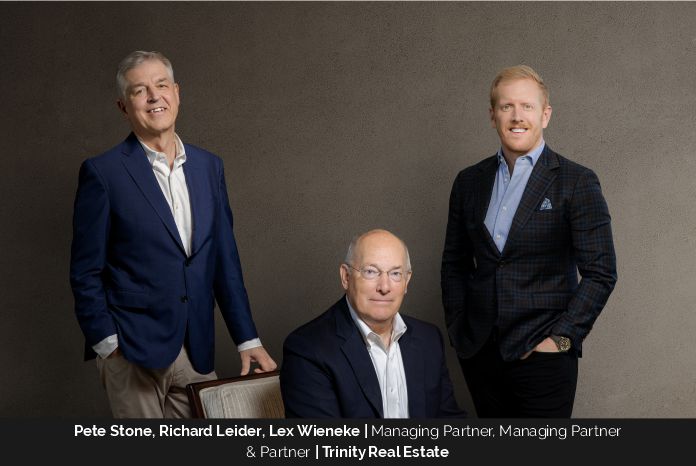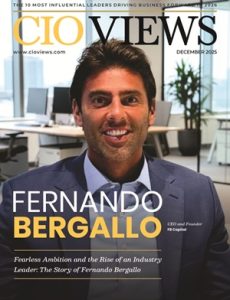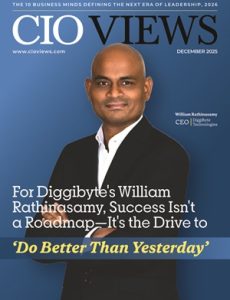In an era where capital moves faster than a phone unlocks, the most discerning families are asking a sharper question about real estate: how do we turn property into a multigenerational operating system for wealth, not just a line on the balance-sheet? Few firms strike a balance between institutional sophistication and the deeply personal dynamics of family governance. Trinity Real Estate, founded in 2001, has become a quiet force, reshaping how family offices and high-net-worth principals approach commercial real estate: not as a string of transactions, but as a cornerstone of legacy.
At the helm are Richard Leider, Pete Stone, and Lex Wieneke. Together, they built Trinity on a philosophy designed to bridge what they repeatedly observed in practice: institutions contribute rigor and repeatability, while families bring purpose, values, and a long-term horizon. The firm combines these strengths into a thoughtful process. For Trinity, real estate is not only about financial returns but also about relevance and stewardship—anchored in fiduciary discipline, governance fluency, intergenerational alignment, and an operator’s eye for value creation.
Thesis: The most valuable real estate strategy for families is the one that compounds both capital and cohesion across generations.
A Founder’s Vision: From Asset Manager to Family-Office Partner
Trinity’s story begins with conviction. In its earliest chapter, the firm was a traditional asset manager, optimizing leases, expenses, capital projects, and debt. But as Richard Leider worked alongside multigenerational families, he saw a wider gap between what properties needed and what families actually wanted: control, clarity, and confidence that every decision advanced wealth and family values over future generations.
“I saw too many families outsourcing their control, or worse, losing alignment across generations,” Richard recalls. “Trinity was born from the belief that families deserve a partner who brings the discipline of institutions and the heart of legacy planning.”
Leider brings a unique blend of academic and practical training to that mission, with executive training at the University of Oxford (AMP, Management Science) and foundational study at the University of Washington’s Foster School of Business. Under his leadership, Trinity has experience spanning over $10 billion in advisory, development, and investment activity, as well as more than 3.6 million square feet of office, residential, retail, hotel, mixed-use, and industrial properties.
He was soon joined by Pete Stone, a senior leader who now oversees business development, asset management, and acquisitions. Stone combines a BS from Cornell University’s School of Hotel Administration with an MBA in Finance from NYU’s Stern School of Business. His reputation is a blend of operator and educator; he has served as an adjunct professor at the University of Washington’s Runstad Department of Real Estate for more than 11 years, and his sensibility is grounded in the daily realities of owner, tenants, and capital markets.
While Pete still rolls up his sleeves for execution, his center of gravity lies in leadership, setting Trinity’s three-to five-year direction, aligning the team to hit those targets, and ensuring the market understands what makes the firm’s approach different.
Rounding out the leadership, Lex Wieneke brings a dynamic blend of on-the-ground execution and institutional rigor. At Trinity, he leads acquisitions and oversees asset management, ensuring each property and capital decision is tuned to market conditions and long-term family priorities. He operates with an investor’s mindset, translating investment policy into day-to-day execution and aligning asset-level actions with portfolio strategy and client value. Previously, he invested through the Great Recession and advised occupiers across office, retail, and industrial sectors at CBRE. He holds a BSBA in Real Estate & Finance from the University of Denver, as well as a Commercial Real Estate Certificate from the University of Washington.
Together, these three built more than a firm; they have built a long-term partner and a philosophy for families and institutions across the United States. One that helps families make better decisions, institutionalize what works, and prepare the stewards who will inherit the keys. Because when done right, real estate isn’t just about returns; it’s about relevance and aligning holdings with the evolving priorities, values, and goals of each generation.
More Than Real Estate: A Fiduciary Approach
Most advisors begin with the asset. Trinity begins with the family. That starting point changes everything, from what you buy to how you hold it, how its reported, and how you educate the rising generation. Before a single pro forma is built, Trinity clarifies long-term objectives, risk posture, governance structure, and distribution needs. Only then are those goals translated into a durable real estate plan, one designed to withstand market cycles and leadership transitions while delivering cash flow, tax-efficient growth, and clarity around risk.
- Strategic architecture that defines decision rights, reporting cadence, and investment policy, so choices are consistent and aligned with purpose.
- Operating model that turns strategy into daily, weekly, and quarterly work so capital plans, leasing, financing, and asset improvements move in rhythm with the family’s objectives.
When these two halves align, real estate becomes an engine for both compounding and cohesion. Stakeholders share a common language, performance rolls up to family objectives, and decisions feel calm, even in volatile markets. The result is not just well-managed assets, but a well-governed legacy.
Trinity’s Six Pillars
If stewardship is the goal, process is the edge. Trinity’s work isn’t a string of one-off transactions; it’s a repeatable system that turns a family’s values and objectives into daily decisions at the property level. These six pillars are the spine of that system, each strong on its own, and transformative in combination. Together, they convert intent into execution, and execution into compounding results.
- Strategic Advisory & Succession Planning – Define vision, risk tolerance, governance, and decision rights. Translate family values into an Investment Policy Statement and a real-estate charter that endures leadership transitions.
- Portfolio & Asset Management – Establish cadence, KPIs, and dashboards. Recast underperformers, double‑down on winners, and create capital plans that balance income needs with compounding.
- Transaction Services – Buy and sell with purpose. Execute 1031s, ground leases, and selective dispositions that improve the portfolio’s risk-return profile.
- Financing Solutions – Underwrite debt from a family balance-sheet perspective. Determine where private credit or preferred equity is additive, and sequence maturities to preserve optionality.
- Development Services – From entitlement to delivery, apply institutional discipline to evaluation, budgeting, vendor selection, and JV formation. Act as the owner’s representative to control scope, schedule, and cost while protecting downside.
- Direct Co‑Investment Program – Pair institutional access with family-office control. Each opportunity is hand-selected and fully underwritten, with transparent assumptions and deal-level reporting. Investors participate as co-owners, shaping hold periods, capital plans, and exits while Trinity invests alongside them to align economics. The result is curated diversification, cleaner incentives, and tax-efficient ownership designed for long-term stewardship.
The Trinity Process: Discovery → Strategy → Implementation → Measure
A clear cadence turns complex portfolios into calm decisions. Trinity’s process is deliberate, repeatable, and transparent. Built to align every action with the family priorities.
Discovery. Trinity sits with principals and next-gen leaders to surface goals: liquidity, distributions, safety, growth, control, and impact. The team also maps decision rights and conflict-resolution protocols up front, so governance is clear before capital moves.
Strategy. Existing holdings are analyzed against market conditions, tax posture, and the family’s investment policy. Trinity sets the pacing, defines target asset types and markets, and designs a financing approach, determining when to refinance, sell, hold, or develop, allowing the portfolio to move with purpose.
Implementation. Trinity executes acquisitions, development, recapitalizations, 1031 exchanges, JV structures, and portfolio-level business plans. They establish a management rhythm of quarterly reviews, lease-up playbooks, and CapEx governance.
Measure. Families receive reporting that rolls property performance up to portfolio KPIs and family objectives. Metrics track NOI, DSCR, rollover and maturity ladders, capital plans, and risk flags; tying results back to distributions, liquidity runway, and long-term compounding.
BREAKOUT BOX
Stewardship Vs. Asset Management
Q. What is the Difference Between Stewardship & Asset Management?
A: Asset management optimizes property-level performance, encompassing leasing, expenses, capital projects, and financing. Stewardship sits above that. It adds governance, tax strategy, education, and intergenerational alignment, ensuring that asset-level actions reinforce the family’s purpose and long-term plan. It’s how families keep capital and cohesion moving in the same direction.
Inside the Trinity Approach: From Parking Garages to Generational Prosperity
In the mid-1940s, a Seattle-based family acquired two parking garages in the heart of downtown. As Seattle transformed into a booming tech hub, the land beneath those garages became some of the most coveted real estate in the region.
As offers to lease or purchase garages poured in, the family found themselves at a crossroads. Do we lease, sell, or hold? Each option carried implications not just for returns, but for taxes, succession, and family alignment. That’s when the family turned to Trinity.
“We wanted to be wise about our decision,” recalls a family member. “Trinity never tried to hard-sell us on any one option. They made sure we understood every path forward.”
Trinity’s role began with education, clarifying the family’s choices, aligning the different generations involved, and ensuring every voice was heard. When one prospective lessor pivoted unexpectedly and offered to buy a garage on extraordinarily favorable terms, Trinity helped the family navigate the sale with speed and precision.
The real challenge came next: reinvesting the proceeds. A traditional sale would have triggered significant capital gains taxes. Instead, Trinity structured an IRS 1031 exchange, giving the family 45 days to identify and secure replacement assets. Within that window, Trinity recommended a portfolio of apartment properties designed to deliver consistent, tax-efficient cash flow while diversifying risk.
In the end, Trinity acquired five high-quality assets that not only protected the family from a hefty tax bill but also significantly increased distributions. Encouraged by the results, the family later sold the second garage, with Trinity once again guiding the reinvestment process. Today, the firm manages a portfolio of eight properties for the family, overseeing capital improvements, monitoring performance, and ensuring the assets remain aligned with the family’s long-term goals.
“Every step of the way, they were as careful with our money as if it were their own,” says the family’s patriarch. “I can’t imagine anyone doing a better job. To anybody looking for help with any real estate investment, I’d say, do not look anywhere else.”
Case Study: A Family Office Finds Its Strategic Partner
Sometimes the best endorsement comes not from institutions, but from seasoned investors who know how to measure value. One such client, a Seattle-based venture capitalist and founder of one of the region’s most successful private equity firms, had built his reputation on spotting opportunity. When it came time to diversify his family office’s portfolio into real estate, he sought the same combination of expertise and control that made him successful in his venture investments.
After consulting with several national wealth management firms, he came away unconvinced. They offered scale, but not the hands-on, real estate-specific strategy he was seeking. Instead, he turned to Trinity Real Estate, a team he had worked with in the past.
What began as an interest in low-touch, long-term holds quickly evolved. Guided by Trinity, the family shifted toward assets with greater value-lift potential. Within a few years, Trinity had acquired three additional assets for the family, two multifamily properties and one industrial site, all in prime locations with strong fundamentals.
Through repositioning and active management, Trinity not only unlocked significant value increases but also created a steady cash-flow stream to support the family office’s broader strategy. Alongside the investments, Trinity provided education and mentorship to the next generation, preparing a family member to eventually take over day-to-day management eventually, a goal set from the outset.
“I was looking for a firm that could teach us,” the client reflects. “Trinity has really become the ultimate partner.”
Building a Recession-Resistant Portfolio
A well-structured portfolio isn’t built from the last cycle; it’s built for the next five. Trinity’s cycle tested approach focuses on what families can control: cash flow, risk, tax posture, governance, and capability transfer.
When you think about generations, you have to consider permanence and how decisions will resonate over time,” says Lex Wieneke. “Our job is to make sure today’s choices can be explained and defended twenty years from now.”
Design for Cash Flow and Optionality
Families need income for distributions, philanthropy, and liquidity events, but they also need dry powder for opportunity. Build a barbell: stabilized income assets on one end, and selective value-added or development on the other. The portfolio “earns its keep” while retaining the option to pounce on dislocation.
Manage Risk Where It Lives
Concentration is hidden everywhere: in tenants, markets, loan maturities, and sponsor relationships. Map each exposure, set guardrails, and monitor it closely. Use lease laddering, staggered debt maturities, diversified counterparties, and pre-funded capex to avoid single points of failure; stress-test to prevent any single point of failure from becoming a major issue.
Be Tax‑Native
Tax isn’t a footnote; it’s a design variable. Pre-wire the pathways, such as 1031 exchanges, cost segregation, properly structured ground leases, and family-specific entity design, so after-tax outcomes are engineered, not discovered at closing. Build the tax plan into the original investment memo, not the closing checklist.
Institutionalize Reporting and Governance
Create an Investment Policy Statement for the portfolio. Define decision rights (who decides what, by when, and how disagreements are resolved). Set an Investment Committee cadence. Track the right KPIs (NOI, DSCR, rollover and maturity ladders, capex plan, risk flags) and publish an Annual Real Estate Letter to all stakeholders. Clarity is the cheapest risk hedge in the market.
Educate the Rising Generation by Doing
Curriculum matters: reps matter more. Start with a small asset or Joint Venture where G2/G3 owns a discrete KPI, such as leasing velocity, lender relations, or vendor selection, supported by Trinity’s playbooks and a monthly scorecard. Competence and confidence rise together when next-gen stewards run real reps on real assets.
The Trinity Difference
Families don’t hire Trinity for volume; they hire Trinity for their expertise and judgment. Trinity’s leaders bring decades of experience across investment, development, asset management, and family governance backed by a culture that prizes clarity over complexity and alignment over adrenaline.
What clients notice most:
- A cadence that calms decision-making and invites consensus.
- Benchmarking and narratives that make complex portfolios readable.
- A bias toward value creation that feels prudent, not promotional.
- Education that turns beneficiaries into stewards.
“Families aren’t looking for the next great deal. They’re looking for continuity,” says Pete Stone. “Our job is to ensure real estate supports that goal, not distracts from it.”
The Road Ahead: Legacy in Motion
As family offices become more global, values-driven, and sophisticated, Trinity continues to evolve. Richard sees the future in expanding Trinity’s geographic reach, while insisting on continuing to do things the right way: measured, intentional, and enduring. With many families navigating generational wealth transitions, Pete believes the firm is uniquely positioned to manage the handoff with calm, capability, and continuity. Lex is focused on cultivating the next generation of leaders across client families and within Trinity.
“We’re not just managing assets,” Lex reflects. “We’re preparing future stewards. That’s the only way legacy truly lasts.”
Real estate wealth management is a relay, not a sprint. The baton isn’t just money; it’s capability and clarity. Real estate is one of the few asset classes that can deliver all three when it’s stewarded with discipline, empathy, and long-term alignment. That’s why, at Trinity Real Estate, the mission has never been transactional; it has always been transformational, growing wealth while aligning it with values, families, and futures.





